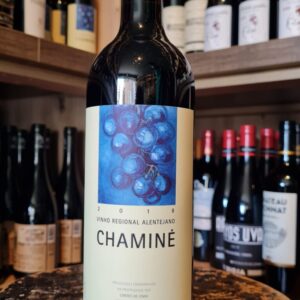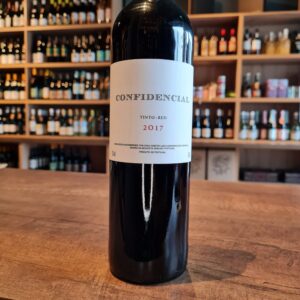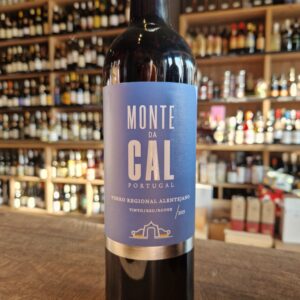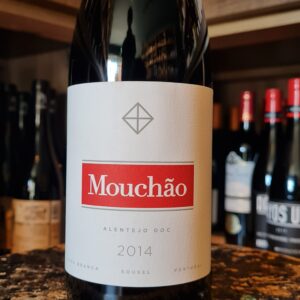Trincadeira (also known as Trincadeira) is a purple-skinned grape used in the production of Port and various other Portuguese red wines. Although Tinta Amarela is the variety’s official name, it is more popularly known as “Trincadeira”, the name under which it is marketed in numerous varietal dry red.
-
 In 1988, A Danish-American couple, Hans and Carrie Jorgensen set out in a sailboat to find a place to start a family and plant vines. They came to Alentejo and they found “Cortes de Cima.” It was just a barren land and a few abandoned buildings. But Carrie, of Portuguese ancestry, said the landscape reminded her of California, her homeland. Hans, who was born in Denmark, fell in love with the Mediterranean sun. Their first wine was "born" in 1998 and the many successful vintages which followed as well as their pioneering spirit have put Cortes de Cima on the map. The main grape used is Aragonez (Spanish call it Tempranillo). It has a overt nose of fresh cherries, red plum, dark fruits and a lick of black liquorice. It is vibrant and well-rounded on the palate with good acidity and body. There is so much to love about this wine. One of my favourites enjoy!!
In 1988, A Danish-American couple, Hans and Carrie Jorgensen set out in a sailboat to find a place to start a family and plant vines. They came to Alentejo and they found “Cortes de Cima.” It was just a barren land and a few abandoned buildings. But Carrie, of Portuguese ancestry, said the landscape reminded her of California, her homeland. Hans, who was born in Denmark, fell in love with the Mediterranean sun. Their first wine was "born" in 1998 and the many successful vintages which followed as well as their pioneering spirit have put Cortes de Cima on the map. The main grape used is Aragonez (Spanish call it Tempranillo). It has a overt nose of fresh cherries, red plum, dark fruits and a lick of black liquorice. It is vibrant and well-rounded on the palate with good acidity and body. There is so much to love about this wine. One of my favourites enjoy!! -
 Easy to drink and Portuguese through and through. Great companion to any celebration and can easily keep up. People pleaser is the word that comes to mind. Would suggest this one for weddings or any events, as it will deliver. Well priced and won't empty your pockets. Get it, enjoy it....responsibly obviously! Easy meals, canapes and cured meats with soft cheeses will go down well with this wine. Keep it confidential and do NOT tell anyone about this wine. It's our secret.
Easy to drink and Portuguese through and through. Great companion to any celebration and can easily keep up. People pleaser is the word that comes to mind. Would suggest this one for weddings or any events, as it will deliver. Well priced and won't empty your pockets. Get it, enjoy it....responsibly obviously! Easy meals, canapes and cured meats with soft cheeses will go down well with this wine. Keep it confidential and do NOT tell anyone about this wine. It's our secret. -
 This is the first wine made by Esporão back in 1985. Label illustrated by António Poppe that changes with every organic vintage. Classic wine style made from estate grown grapes that shows the consistency and the rich, ripe fruit characters which are typical of the best Alentejo red wines. Deep dark red colour with intense spicy aroma of mature red berry fruits with discrete oak complexity. On the palate it is elegant, dense and creamy.
This is the first wine made by Esporão back in 1985. Label illustrated by António Poppe that changes with every organic vintage. Classic wine style made from estate grown grapes that shows the consistency and the rich, ripe fruit characters which are typical of the best Alentejo red wines. Deep dark red colour with intense spicy aroma of mature red berry fruits with discrete oak complexity. On the palate it is elegant, dense and creamy. -
 It is in the heart of the genuine Alentejo, with its unique aromas, flavors and textures, nature, silence and immensity, that the 80 hectares of vineyards at Herdade Monte da Cal, located in the municipality of Fronteira, in the parish of São Saturnino, extend over 80 hectares of vineyards. about 40 km from Portalegre. Surrounded by the tranquility of the northern Alentejo plain, it is part of the calm environment of nature characteristic of this part of the country, surrounded by an infinity of vineyards, which we can only see, far away. Here, the red varieties Trincadeira, Syrah, Aragonês, Alicante Bouschet, Alfrocheiro and Touriga Nacional are planted. The architecture and decoration of the estate reflect the Arab influences, so present in the Alentejo culture. The estate’s modern winery is a fundamental pillar to reinforce the visibility of the wines of this house, and a wine tourism project is already planned for this property. Suggested pairing with dishes from the Mediterranean, Chinese, Indian and African cuisine.
It is in the heart of the genuine Alentejo, with its unique aromas, flavors and textures, nature, silence and immensity, that the 80 hectares of vineyards at Herdade Monte da Cal, located in the municipality of Fronteira, in the parish of São Saturnino, extend over 80 hectares of vineyards. about 40 km from Portalegre. Surrounded by the tranquility of the northern Alentejo plain, it is part of the calm environment of nature characteristic of this part of the country, surrounded by an infinity of vineyards, which we can only see, far away. Here, the red varieties Trincadeira, Syrah, Aragonês, Alicante Bouschet, Alfrocheiro and Touriga Nacional are planted. The architecture and decoration of the estate reflect the Arab influences, so present in the Alentejo culture. The estate’s modern winery is a fundamental pillar to reinforce the visibility of the wines of this house, and a wine tourism project is already planned for this property. Suggested pairing with dishes from the Mediterranean, Chinese, Indian and African cuisine. -
 Herdade do Mouchao is a historic winery in Portugal’s Alentejo region that specialises in producing excellent red wines from the local Alicante Bouschet grape. The estate’s roots date back to the 19th century when Thomas Reynolds first moved from Porto to Alentejo to enter the prosperous cork-making industry. Later his grandson, John Reynolds saw an opportunity to start making both wine and corks and purchased the 900 hectare Herdade do Mouchao estate. Vineyards were planted, in 1901 he built a high-ceilinged adobe winery (or “adega”) and a distillery was added to the winery in 1929, where until today Mouchão's pommace brandy is produced. Unfortunately the estate was seized in 1974 by order of the powerful military government ruling the country at the time. The Reynolds were only able to regain the estate in 1985 and today the family works around 38 hectares of vines. Today, the Herdade do Mouchão continues to be run by the descendants of the original family whose cellar and vineyard workers have been with them for generations. The process is, as it always has been, unhurried (There is alway Manana). The grape varieties are local, picked by hand and foot-trodden. In the ever-changing world of winemaking, Herdade do Mouchão, remains a traditional, family-run winery.
Herdade do Mouchao is a historic winery in Portugal’s Alentejo region that specialises in producing excellent red wines from the local Alicante Bouschet grape. The estate’s roots date back to the 19th century when Thomas Reynolds first moved from Porto to Alentejo to enter the prosperous cork-making industry. Later his grandson, John Reynolds saw an opportunity to start making both wine and corks and purchased the 900 hectare Herdade do Mouchao estate. Vineyards were planted, in 1901 he built a high-ceilinged adobe winery (or “adega”) and a distillery was added to the winery in 1929, where until today Mouchão's pommace brandy is produced. Unfortunately the estate was seized in 1974 by order of the powerful military government ruling the country at the time. The Reynolds were only able to regain the estate in 1985 and today the family works around 38 hectares of vines. Today, the Herdade do Mouchão continues to be run by the descendants of the original family whose cellar and vineyard workers have been with them for generations. The process is, as it always has been, unhurried (There is alway Manana). The grape varieties are local, picked by hand and foot-trodden. In the ever-changing world of winemaking, Herdade do Mouchão, remains a traditional, family-run winery.

